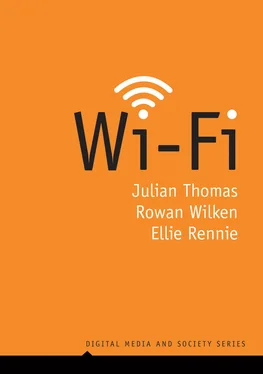According to the International Monetary Fund (2020, p. xv), the world after Covid-19 is likely to be poorer and more unequal for many years to come. The pandemic has reversed global progress in reducing poverty, with only a protracted and gradual recovery expected. If we think about the impact of the pandemic on digital inequality, we see a particularly fluid and challenging dynamic. Governments and businesses are responding to Covid-19 by hastening the transition to online services. While digital transformation has many benefits, it also magnifies the problem of digital inequality – a problem with no simple fix, and many dimensions: it involves access to networks, devices, applications, and content; the cultivation of a diverse range of skills and capabilities. Digital inclusion is also about affordability – what proportion of people’s incomes do we expect them to pay for essential communication and services? Wi-Fi networks have the potential to address directly problems of access and cost, and can contribute indirectly to boosting skills and capacities. This is why, in August 2020, the South Korean government announced plans to install 41,000 free public Wi-Fi hotspots by 2022, and to upgrade 18,000 older installations (Cho, 2020). It appears that Wi-Fi will continue to matter, and its role may grow in importance.
Wi-Fi through past and present
In the chapters that follow, we explore the historical trajectories of Wi-Fi in order to illuminate its present significance. We discuss Wi-Fi’s deep foundations in twentieth-century theories of wireless communication; its more immediate origins in the 1970s and 1980s, in wireless network experimentation and spectrum policymaking; its emergence as a focus of public and commercial research and development in the 1980s and 1990s; and its subsequent status as an evolving set of technical protocols supporting an accelerating proliferation of devices and ‘smart’ technologies. Our approach throughout is not to focus on the technical aspects of Wi-Fi – we note that the relevant standards in any case comprise a large and evolving group of technologies – but on its social and institutional contexts, its uses and applications.
We have already begun to sketch the place of Wi-Fi in contemporary digital experience. We now turn to a closer consideration of what its history tells us about the significance of Wi-Fi in its many guises – as marketing strategy, as technical protocol, as open industry standard, as public utility, and as intellectual property. Wi-Fi raises intriguing questions: about the prominent visibility of this embedded, mainly hidden form of infrastructure; about the control and ownership of Wi-Fi’s open standards; and about the place of Wi-Fi between the commercial tech industries, public utility, and the worlds of low-cost community and domestic networks. In order to address these questions, we can draw on both recent developments and some salient lessons from Wi-Fi’s complex past.
When Steve Jobs unveiled the iBook laptop, he didn’t talk about Wi-Fi – the wireless networking features were branded with an Apple trademark, ‘AirPort’, conveying the idea that these industry standard capabilities would be ‘first and best’ on Apple’s machines. As other firms began to build those same capabilities into many other computers and base stations, the AirPort name inevitably became one of many used to market wireless networking gear. What became known as Wi-Fi was generally designated as ‘802.11’, the number given to the relevant family of wireless standards developed for local networks within the Institute of Electrical and Electronics Engineers, known as the IEEE.
For those manufacturers and developers keen to promote the new standards, several issues were quickly apparent. Jobs emphasized the fact that AirPort used the new industry standard, and therefore would work with a whole array of devices soon to appear. But the 802.11 standards were complex and wide-ranging, with the result that not all compliant devices using the same standard were assured to work together, and the IEEE’s role in specifying the agreed standard did not extend to testing devices for compliance. Further, 802.11 was, as we have noted, a family of standards, with each iteration given a specific alphabetic suffix. The standard used in Apple’s 1999 iBook and other early consumer systems was 802.11b, to be followed in time by 802.11g, 802.11n, 802.11ac, and many others. These different versions of Wi-Fi all involved significant improvements, but the nomenclature was difficult to follow or comprehend for those without specialist knowledge.
A new trade organization emerged, the Wireless Ethernet Compatibility Alliance, to promote the new wireless networking and certify that devices would work together. For this purpose, a new name was required. Interbrand, a transnational marketing consultancy with previous successes including Prozac and oneworld, was commissioned. Interbrand conceived the ‘Wi-Fi’ name, together with a logo that borrowed (or appropriated) familiar yin-yang symbolism. The point was plainly to synthesize a brand, something that could be registered, licensed, and controlled through trademark law. The alliance itself became the ‘Wi-Fi Alliance’. The name ‘Wi-Fi’ was coined in part because it could be readily trademarked – no-one else used it, nor could it be confused with anything else. It was an entirely arbitrary name which meant nothing. The word did play with ‘Hi-Fi’, an abbreviation for ‘high fidelity’ with a certain retro cachet from the world of consumer audio. However, the evidence is that the Wi-Fi name was not intended to signify ‘wireless fidelity’, or be an abbreviation for anything. The Alliance nevertheless confused the issue by adopting for a time the slogan ‘the standard for wireless fidelity’ – a formula that was developed after the name had been chosen, and meant very little. It was noted that no-one knew what wireless fidelity was, and the Alliance was not a standard-setting body (Doctorow, 2005).
The Wi-Fi Alliance currently controls around fifty Wi-Fi-related brands (Wi-Fi Alliance, 2020a). While the trademarked name plays a critical role in stabilizing a complex and evolving group of technologies, it is also surprisingly multivalent itself. Just as Humpty Dumpty once reserved for himself the right to decide what a word meant, the Wi-Fi Alliance can decide what Wi-Fi means in any given context. The Alliance’s current vision is ‘connecting everyone, everything, everywhere’. From hotspots to encryption and set-up systems, the Alliance’s Wi-Fi trademarks cover a remarkable range of applications and uses, as well as the many versions of the main networking protocols. The brands are of two main kinds: those for public use – such as the generic ‘Wi-Fi’ name itself – can be used by anyone to describe or refer to Wi-Fi products. These are licence-free, subject to a small number of requirements and prohibitions, including rules about how the word should be capitalized and hyphenated. Then there are the certification marks, exclusively for the use of Alliance members, intended to function as a ‘seal of approval’ for products guaranteeing interoperability, security, and compliance with relevant protocols. These are subject to strict rules and prohibitions. Meanwhile, the Alliance’s branding strategy has continued to evolve, and the reach of the Wi-Fi brand has continued to expand. For many years it was used alongside the IEEE’s 802.11 alphabet soup of different versions, so products using the Wi-Fi name and logo would also specify compatibility with ‘802.11ac’ or other versions. In 2018, the Alliance began a retrospective rebranding, known as ‘generational Wi-Fi’, requiring the different iterations of Wi-Fi to be rebadged as ‘Wi-Fi 4’, ‘Wi-Fi 5’, and so on. The Alliance’s documentation draws an explicit comparison with the effective marketing of ‘generational’ cellular technologies such as 4G and 5G.
Читать дальше










